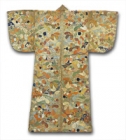Japanese Gallery (Honkan) Room 9
October 31, 2006 (Tue) - December 6, 2006 (Wed)
Funabenkei is one of the major works by the Noh playwright Kanze Kojiro Nobumitsu (1435-1516), active from the middle to late Muromachi period (1392-1573). Featuring lavish costumes, singing, and dancing, the play shows an inclination toward the revue style. The famous scene of Taira no Tomomori's ghost is an animated and spectacular highlight of this drama, with the ghost wearing a showy costume and wielding a halberd, attacking Minamoto no Yoshitsune and his men.
The play is based on the tragic story of Minamoto no Yoshitsune (1159-1189), the hero in the war between Genji (Minamoto clan) and Heike (Taira clan). The story, taking place shortly after Heike was overthrown, begins with Yoshitsune's escape to the western provinces, accompanied by the priest-warrior Musashibo Benkei (?-1189) and other followers, from his older brother Yoritomo who saw Yoshitsune's popularity as a threat. At a boathouse on Daimotsunoura beach in Settsu province, they meet Yoshitsune's lover Shizuka Gozen, who had followed them. The actor performing Shizuka's role wears a karaori garment without trousers and a ko-omote, a mask for a young women's role. In addition, Shizuka wears a gold-painted eboshi cap since she once was a shirabyoshi, a kind of entertainer who sings and dances in men's attire. Yoshitune explains how dangerous it is for a girl to run with him and persuades her to go home. With tearful eyes, Shizuka dances to pray for her lover's safety and leaves.
Soon after Yoshitsune sets sail, a storm suddenly begins. Then, an apparition with loosely-hanging hair and a kuwagata, a beetle horn-like helmet ornament, appears from the horizon. The apparition is wearing mikazuki, a fierce mask with golden eyes, and a happi coat over atsuita and hanrigi trousers. He attacks Yoshitsune and his men with a halberd. Yoshitsune recognizes the ghost to be Taira no Tomomori (1152-1185), whom he had defeated. Tomomori had drowned himself at the end of the crucial sea battle of Dannoura. In the end, however, Benkei's powerful prayer was able to defeat the ghost.

